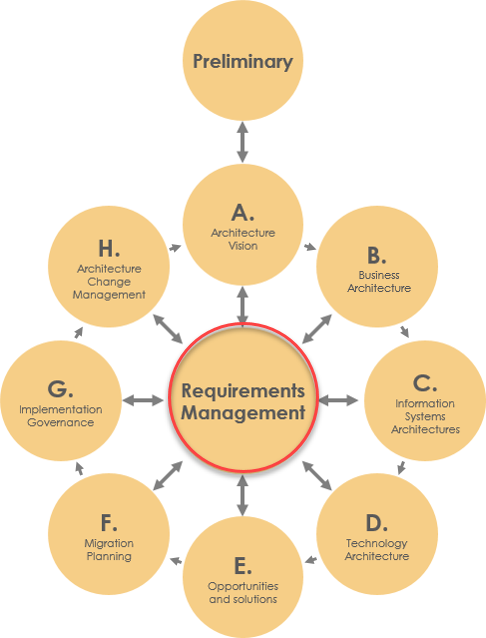Understanding TOGAF’s Requirement Management Phase and Its Role in the TOGAF ADM
Introduction
The Open Group Architecture Framework (TOGAF) is a widely adopted enterprise architecture methodology that provides a structured approach to designing, planning, implementing, and managing an organization’s enterprise architecture. TOGAF is based on the Architecture Development Method (ADM), which consists of several phases that guide the creation of an enterprise architecture. One crucial phase within TOGAF is the Requirement Management Phase.
In this article, we will delve into the Requirement Management Phase’s significance, its relationship to the TOGAF ADM, its objectives, the key stakeholders involved, and the formation of teams. We will also provide real-world examples to illustrate the practical application of this phase.

Understanding the TOGAF ADM
Before we dive into the Requirement Management Phase, it is essential to grasp the overall structure of the TOGAF ADM. The TOGAF ADM consists of several phases, each serving a specific purpose and contributing to the development of an enterprise architecture. These phases are as follows:
- Preliminary Phase
- Phase A: Architecture Vision
- Phase B: Business Architecture
- Phase C: Information Systems Architecture
- Phase D: Technology Architecture
- Phase E: Opportunities and Solutions
- Phase F: Migration Planning
- Phase G: Implementation Governance
- Phase H: Architecture Change Management
- Requirements Management Phase
The Requirement Management Phase is a critical component of the TOGAF ADM and is closely connected to other phases, such as Phase E (Opportunities and Solutions), Phase F (Migration Planning), and Phase H (Architecture Change Management). It plays a pivotal role in ensuring that the architecture development process aligns with stakeholder needs and business goals.
The Significance of the Requirement Management Phase
The Requirement Management Phase primarily focuses on identifying, documenting, and managing the various requirements that drive the architecture development process. Requirements in this context can encompass a wide range of elements, including business objectives, stakeholder concerns, regulatory constraints, and technology constraints. The primary objectives of this phase are as follows:
- Stakeholder Alignment: Ensure that the architecture aligns with the needs and concerns of key stakeholders, such as business leaders, IT managers, and regulatory bodies.
- Requirements Capture: Identify and document all relevant requirements, both functional and non-functional, to guide the architecture development process.
- Traceability: Establish traceability between requirements and architecture elements, enabling architects to track how each requirement is addressed within the architecture.
- Prioritization: Prioritize requirements based on their importance and impact on the organization’s objectives.
- Change Management: Manage changes to requirements throughout the architecture development process, ensuring that the architecture remains adaptable and responsive to evolving needs.
People Involved in the Requirement Management Phase
The Requirement Management Phase involves several key stakeholders who collaborate to ensure the successful execution of this phase. These stakeholders include:
- Enterprise Architects: These professionals are responsible for overseeing the Requirement Management Phase and ensuring that the identified requirements align with the overall enterprise architecture.
- Business Analysts: Business analysts play a crucial role in gathering and analyzing business requirements, translating them into architecture-related terms, and ensuring that they are well-documented.
- Stakeholders: Various stakeholders, including business leaders, IT managers, and end-users, provide input and feedback on their requirements and concerns.
- Project Managers: Project managers help in coordinating the Requirement Management Phase activities and ensuring that requirements are integrated into project plans and timelines.
Formation of Teams in the Requirement Management Phase
The formation of teams in the Requirement Management Phase depends on the size and complexity of the organization and the architecture project. However, some common teams and their roles include:
- Requirements Gathering Team: This team, led by business analysts, is responsible for engaging with stakeholders, conducting interviews, surveys, and workshops to collect requirements.
- Requirements Analysis Team: This team, including business analysts and enterprise architects, focuses on analyzing collected requirements, identifying patterns, and ensuring that requirements are complete and consistent.
- Requirements Documentation Team: This team is responsible for documenting requirements in a clear, concise, and standardized manner. Documentation includes using tools like requirement catalogs, matrices, and traceability matrices.
- Requirements Review and Approval Team: This team, composed of stakeholders and architecture governance committees, reviews and approves requirements to ensure alignment with business objectives and strategic goals.
Real-World Example
Let’s consider a real-world example of the Requirement Management Phase in action:
Imagine a global retail corporation embarking on a digital transformation initiative. In this scenario:
- Stakeholders: The stakeholders include the CEO, CIO, CFO, store managers, and online sales team members.
- Requirement Gathering Team: Business analysts conduct interviews and workshops with stakeholders to understand their needs. They identify that the CEO wants to enhance the online shopping experience to boost sales, while store managers seek improved inventory management systems.
- Requirements Analysis Team: Business analysts work with enterprise architects to analyze these requirements. They recognize that enhancing the online shopping experience involves improving the e-commerce platform, and inventory management requires a new point-of-sale system.
- Requirements Documentation Team: This team documents these requirements, ensuring they are well-defined and traceable to specific stakeholders.
- Requirements Review and Approval Team: Stakeholders review and approve the documented requirements, ensuring they align with the company’s strategic goals.
Conclusion
The Requirement Management Phase is an essential part of the TOGAF ADM, ensuring that an enterprise architecture project remains focused on stakeholder needs and business objectives. By involving key stakeholders, forming dedicated teams, and following a structured approach, organizations can effectively manage requirements and increase the likelihood of a successful architecture development process. It is through this phase that the architecture truly becomes a powerful tool for driving business transformation and achieving strategic goals.

